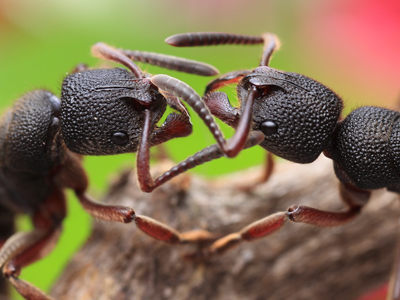
Ask the AI Tutor
Need help with Investigating - Minibeasts? Ask our AI Tutor!
AI Tutor - Lucy
Connecting with Tutor...
Please wait while we establish connection

Studying minibeasts, like these ants, is great fun and science too!
Investigating - Minibeasts
Explore KS1 Science by investigating minibeasts, where they live, and how we can sort them into groups using their bodies, habitats, and behaviours.
1 .
2 .
Josh has a choice chamber. It is divided into four. One part he leaves empty. What should he do with the other three?
Put a little water into one of them
Cover one in card to make it dark
Put a few leaves into one of them
Do all three of these things
If Josh does all three, he will then give the woodlice lots of choices
3 .
Kim helps Josh with his experiment. They put the twenty woodlice into the choice chamber. What should they do?
Shake the choice chamber about
Leave the woodlice for one minute
Leave the woodlice for ten minutes
Tip up the choice chamber
The woodlice need time to find their way around and decide where they like best
4 .
Ryan is going to get the results. What should he do?
Count how many woodlice are in the empty chamber
Count how many woodlice are in the wet chamber
Count how many woodlice are in each chamber
See where the biggest woodlouse has gone
Ryan will have to lift the lid very carefully so as not to disturb the woodlice
5 .
6 .
7 .
8 .
Josh says he thinks they should repeat the experiment. Why does Josh think they should repeat the experiment?
Because it isn’t home time yet
Because he doesn’t like their results
Because he likes investigating woodlice
Because he wants to check if the woodlice do the same thing again
Repeating an experiment is always a good idea, if there is time
9 .
They decide to repeat the experiment. Kim says he thinks they should use the same 20 woodlice. But Joe says they should use a fresh group of 20 woodlice. Why does Joe say this?
Because the first 20 woodlice may have learned where to go
Because he wants to collect more woodlice
Because it’s fun looking under logs
Because Kim is always wrong
In this case, it is a good idea to use new woodlice
**Unlimited Quizzes Await You! 🚀**
Hey there, quiz champ! 🌟 You've already tackled today's free questions.
Ready for more?
Ready for more?
🔓 Unlock UNLIMITED Quizzes and challenge yourself every day. But that's
not all...
not all...
🔥 As a Subscriber you can join our thrilling "Daily Streak" against other
quizzers. Try to win a coveted spot on our Hall of Fame Page.
quizzers. Try to win a coveted spot on our Hall of Fame Page.
Don't miss out! Join us now and keep the fun rolling. 🎉
**Unlimited Quizzes Await You! 🚀**
Hey there, quiz champ! 🌟 You've already tackled today's free questions. Ready for more?
🔓 Unlock UNLIMITED Quizzes and challenge yourself every day. But that's not all...
🔥 As a Subscriber you can join our thrilling "Daily Streak" against other quizzers. Try to win a coveted spot on our Hall of Fame Page.
Don't miss out! Join us now and keep the fun rolling. 🎉














